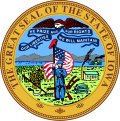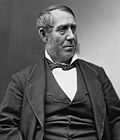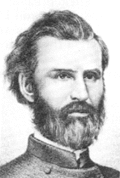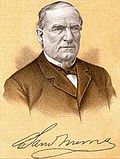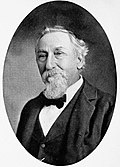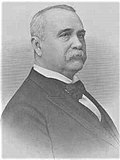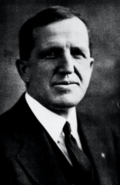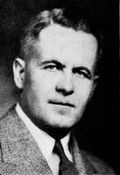Top Qs
Timeline
Chat
Perspective
List of governors of Iowa
From Wikipedia, the free encyclopedia
Remove ads
The governor of Iowa is the head of government of the U.S. state of Iowa. The governor is the head of the executive branch of the state government[2] and is charged with enforcing state laws.[3] The officeholder has the power to either approve or veto bills passed by the Iowa General Assembly,[4] to convene the legislature,[5] as well as to grant pardons, except in cases of treason and impeachment.[6] The governor of Iowa is also the commander-in-chief of the state's military forces.[7] The governor has the ability to sign executive orders, these have range from topics including the establishment of councils, committees and task forces, and appropriation reductions to prevent a state budget deficit.
There have been 41 individuals who held the position of Iowa governor, with two of those serving multiple distinct terms, Samuel J. Kirkwood and Terry Branstad. The current governor, Kim Reynolds, is the first woman to hold the position and was sworn in on May 24, 2017. The longest-serving is Terry Branstad, who served from 1983 to 1999 and then again from 2011 to 2017. He is the longest-serving governor in U.S. history, surpassing the previous record of 21 years set by George Clinton of New York. The shortest-serving was Robert D. Fulton, who served 16 days.
Remove ads
List of governors
Summarize
Perspective
Territory of Iowa
Iowa Territory was formed on July 4, 1838, from Wisconsin Territory. It had four governors appointed by the president of the United States, though the first resigned days after he was confirmed by the Senate and before ever reaching the territory.
State of Iowa
The southeast portion of Iowa Territory was admitted to the Union as the State of Iowa on December 28, 1846. The first Constitution of Iowa, adopted in 1846, created the office of governor with a four-year term,[24] with no specific start date. The 1857 constitution reduced this term to two years,[25] but an amendment in 1972 increased this back to four years.[26] The 1857 constitution also set the start of the term to the second Monday in the January following the election,[27] which was moved one day later by a 1988 amendment.[28]
The office of lieutenant governor was created in the 1857 constitution, elected for the same term as the governor.[29] An amendment in 1988 specified that the lieutenant governor would be elected on the same ticket as the governor.[30] If the office becomes vacant, it devolves upon the lieutenant governor for the remainder of the term or vacancy.[31] Prior to 1857, if the office became vacant, the Secretary of State of Iowa would act as governor.[32] There is no term limit on the number of terms a governor may serve.
Remove ads
Timeline
| Timeline of Iowa governors |
 |
See also
Notes
- The range given is from the date the governor was confirmed by the Senate, or appointed by the President during a Senate recess, to the date the governor left office.
- Lucas did not arrive for six weeks after the territory had been created; in the interim, territorial secretary William B. Conway acted as governor.[11]
- Lucas was out of the capital when Chambers arrived, and did not formally resign his commission until June 17, per a letter written to U.S. Secretary of State Daniel Webster.[14]
- Lieutenant governors represented the same party as their governor unless noted.
- The election schedule changed with this term, switching to odd-numbered years and shortening the term by nearly a year.
- Lowe was instead elected to the Iowa Supreme Court.[45]
- No source appears to know which date Walden resigned, just that it was after being elected to the United States House of Representatives for a term beginning March 4.[58]
- Kirkwood resigned, having been elected to the United States Senate.[49]
- Represented the Republican Party
- Cummins resigned, having been elected to the United States Senate.[88]
- The election schedule changed with this term, switching to odd-numbered years and lengthening the term by nearly a year.
- Hamill instead ran unsuccessfully for the Republican nomination for the United States Senate.[104]
- Herring was instead elected to the United States Senate.[110]
- Wilson was instead elected to the United States Senate.[116]
- Hickenlooper was instead elected to the United States Senate.[119]
- Represented the Democratic Party
- Hughes resigned, having been elected to the United States Senate.[142]
- Branstad resigned, having been confirmed as United States Ambassador to China.[157]
- Reynold's second full term began on January 13, 2023,[160] and will expire on January 15, 2027; she is not running for re-election.[161]
Remove ads
References
External links
Wikiwand - on
Seamless Wikipedia browsing. On steroids.
Remove ads

